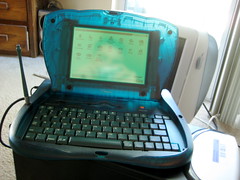On using ‘we’ vs. ‘me’ when blogging
November 6th, 2008I like to go back and read famous Mac-oriented bloggers’ first posts. Maybe it’s a glimpse back into how things used to be, before they got all famous on us, but it’s neat to see the earliest thoughts and ideas of people I read everyday.
While reading John Gruber’s early work on Daring Fireball, I noticed his earliest posts referred to “The Daring Fireball” as a blog, as a self-referential moniker, and as a body of people (“we here at Daring Fireball”). I’ve done the same thing.
So which is it? Do you call your blog by the multi-person “we,” even though – in the case of both Daring Fireball and Newton Poetry – only one person is responsible for all the content?
[And that’s another thing: Maybe it’s my journalism background, and its obsession with style guides, but what is the proper style for mentioning blogs? Do you italicize them, like magazines? Or do you leave them in standard text? Direct links every time you mention them? What say you, reader?]
Since I’m the only one developing copy for Newton Poetry (and yes, I’ve asked for help before), it only makes sense to refer to the blog and myself separately. If I do or discover something, I’ll call it “me.” When something is featured on Newton Poetry, I’ll mention the blog. No more, “We here at Newton Poetry” nonsense. It’s just me. “I found this,” or “A few months ago, Newton Poetry featured…”
Even referring to the blog seems distant and cold – like I’m referencing myself and my work from far away. It’s hard for an abstraction to be paired with a verb (“Newton Poetry did this” is like saying “The number seven ate nine”), especially when it really is me doing all the doing.
John Gruber eventually fell away from “The” and “we,” and now everyone knows it’s his show. That’s what makes it so good: his personality comes across. The “me” is dominant.
Good, one-person blogs are acts of ownership and passion, and I guess I feel there’s no need to step around who’s doing the doing. It isn’t the blog. It’s me. And it’s you, in the comments section.
Together, we make Newton Poetry.





